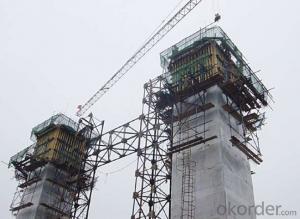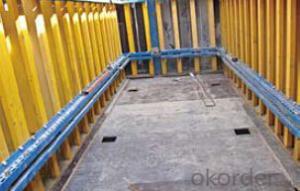Tower Scaffolding for Formwork And Scaffolding Systems
- Loading Port:
- Tianjin
- Payment Terms:
- TT OR LC
- Min Order Qty:
- 50 m²
- Supply Capability:
- 1000 m²/month
OKorder Service Pledge
Quality Product, Order Online Tracking, Timely Delivery
OKorder Financial Service
Credit Rating, Credit Services, Credit Purchasing
You Might Also Like
Tower Scaffolding
Shoring tower is an effective supporting system. It is easy to assemble and dismantlement, and
has excellent stability and bearing capacity. It has been widely used in the construction of industry
& residential buildings , bridges, tunnels and dam project, etc.
Characteristics:
◆ High degree of standardization.
◆ Easy storage and transportation


- Q: Can steel formwork be used in seismic areas?
- Yes, steel formwork can be used in seismic areas. Steel formwork is known for its strength, durability, and stability, making it suitable for use in areas with high seismic activity. It can withstand the forces and vibrations generated during an earthquake, ensuring the safety and stability of the structures being constructed. Additionally, steel formwork allows for faster construction, which is beneficial in seismic areas where time is of the essence in ensuring the safety of the built environment. However, it is important to ensure that the steel formwork is properly designed and installed to meet the specific requirements and codes for seismic design in the given area.
- Q: Can steel formwork be used for underground tunnels?
- Yes, steel formwork can be used for underground tunnels. Steel formwork is a versatile and durable material that is commonly used in construction projects, including underground tunnels. It is able to withstand the pressure and forces exerted by the surrounding soil and rock, making it suitable for use in the construction of tunnels. Additionally, steel formwork is easy to assemble and disassemble, allowing for efficient construction and maintenance of tunnels. Its strength and durability make it a popular choice for underground tunnel construction, providing a reliable and long-lasting solution.
- Q: What are the safety considerations when using steel formwork?
- When using steel formwork, there are several safety considerations that need to be taken into account. Firstly, it is important to ensure that the formwork is properly installed and secured to prevent any collapses or accidents. Regular inspections should be conducted to check for any signs of wear or damage that could compromise its stability. Another safety consideration is the proper handling and storage of steel formwork. It can be heavy and cumbersome, so workers should be trained in proper lifting techniques to avoid strains or injuries. Adequate storage facilities should be provided to prevent any damage or tripping hazards. Additionally, when working with steel formwork, workers should wear appropriate personal protective equipment (PPE) such as helmets, gloves, and safety boots to protect themselves from any potential hazards or falling debris. They should also be trained in safe work practices, including proper use of tools and equipment, as well as the correct procedures for dismantling the formwork after use. Overall, by following these safety considerations, the risks associated with using steel formwork can be minimized, ensuring a safe working environment for all involved.
- Q: I would like to ask the bridge column (D110) steel template thickness should be how much
- Because of the complexity of bridge construction, in addition to the requirements of key templates of high rigidity, high strength, but also the overall requirements of steel formwork has strong adaptability, to meet the different needs of bridge construction, and the steel plate must have strong compatibility or accommodation. The cross section of the pier column steel formwork is round, round, conical, hyperbolic, etc.,
- Q: What are the typical load capacities of steel formwork systems?
- The typical load capacities of steel formwork systems can vary depending on the specific type and design of the system. However, in general, steel formwork systems are known for their high load-bearing capabilities. For horizontal formwork systems such as slab formwork, the load capacities can range from 60 to 100 kN/m2 or even higher, depending on the thickness of the slab and the spacing of the supports. This allows for the efficient construction of reinforced concrete slabs and beams that can withstand heavy loads. Vertical formwork systems, such as wall formwork and column formwork, are designed to withstand both the weight of the fresh concrete and the lateral pressure exerted during pouring. The load capacities of these systems can vary depending on the height and width of the structure being formed. Generally, wall formwork systems can handle loads ranging from 50 to 80 kN/m2, while column formwork systems can support loads ranging from 60 to 100 kN/m2. It is important to note that these load capacities are just general guidelines and may vary depending on the specific design and manufacturer of the steel formwork system. It is always recommended to consult the manufacturer's specifications and guidelines to ensure that the formwork system is used within its designated load capacities for safe and efficient construction.
- Q: How does steel formwork affect the construction schedule?
- Steel formwork can greatly affect the construction schedule in a positive way. Due to its strength and durability, steel formwork allows for faster and more efficient construction processes. This results in reduced construction time and faster completion of the project. Additionally, steel formwork is reusable, which further saves time and resources as it can be quickly dismantled and used for future construction projects.
- Q: Can steel formwork be used for road construction?
- Yes, steel formwork can be used for road construction. It provides a sturdy and durable solution for shaping and supporting concrete during the road construction process. Steel formwork offers excellent strength, stability, and reusability, making it an ideal choice for constructing roads.
- Q: Are there any disadvantages to using steel formwork?
- Using steel formwork does have its drawbacks. One major disadvantage is the steep initial cost associated with it. Compared to other formwork options like wood or plastic, steel formwork is pricier to purchase or rent. This can pose a significant challenge for smaller construction projects or contractors operating on a tight budget. Another drawback lies in the weight of steel formwork. It is considerably heavier than alternative materials, making it more difficult to handle and transport. This can result in increased labor costs and a greater need for manpower when setting up or dismantling the formwork. Moreover, assembling and dismantling steel formwork requires skilled labor. It is crucial to have experienced workers who possess the knowledge of correct procedures and techniques to ensure the safety and stability of the formwork. This, in turn, can contribute to higher project costs and extended timelines. Steel formwork is also susceptible to corrosion if not properly maintained. Exposure to moisture and chemicals can lead to rust and deterioration, compromising the formwork's integrity and posing safety risks. Regular inspections and maintenance are necessary to prevent and address corrosion issues. Lastly, steel formwork lacks the flexibility and adjustability found in other types of formwork. Once it is fabricated, it becomes difficult to modify or adjust to accommodate changes in design or dimensions. This inflexibility can be a disadvantage in projects where modifications or adjustments are frequently required. In conclusion, while steel formwork does offer advantages such as durability and reusability, it is important to consider its disadvantages when selecting the appropriate formwork for a construction project.
- Q: Can steel formwork be used for both horizontal and vertical concrete elements?
- Yes, steel formwork can be used for both horizontal and vertical concrete elements. Steel formwork provides strength, stability, and durability, making it suitable for a wide range of construction projects. Its versatility allows for the creation of various shapes and sizes, making it a preferred choice for both horizontal slabs and vertical walls.
- Q: How does steel formwork handle concrete vibration and air entrapment?
- Steel formwork is highly effective in handling concrete vibration and minimizing air entrapment during the pouring and curing process. Firstly, steel formwork is known for its high strength and rigidity, which allows it to withstand the intense vibrations caused by concrete compaction. When concrete is poured into steel formwork, the formwork itself acts as a barrier, preventing excessive movement or deformation that could lead to the formation of voids or air pockets. This ensures that the concrete is evenly distributed and compacted throughout the structure. Additionally, steel formwork is designed with tight joints and smooth surfaces, which helps in reducing air entrapment. The joints are tightly sealed to prevent any leakage, which could result in air being trapped within the concrete. This is particularly important as air pockets can weaken the structural integrity and durability of the concrete. The smooth surfaces also aid in the easy flow and consolidation of the concrete, reducing the chances of air entrapment. Furthermore, steel formwork can be easily customized and adjusted to fit the specific requirements of the construction project. This allows for precise and accurate placement of the formwork, ensuring that the concrete is poured and compacted in the desired manner. By having complete control over the formwork, the risk of air entrapment can be minimized, resulting in a more durable and reliable concrete structure. In conclusion, steel formwork is an excellent choice for handling concrete vibration and air entrapment. Its strength, rigidity, tight joints, and smooth surfaces provide the necessary stability and control during the pouring and compaction process. By using steel formwork, construction professionals can ensure that the concrete is properly consolidated and free from air pockets, resulting in a high-quality and long-lasting structure.
Send your message to us
Tower Scaffolding for Formwork And Scaffolding Systems
- Loading Port:
- Tianjin
- Payment Terms:
- TT OR LC
- Min Order Qty:
- 50 m²
- Supply Capability:
- 1000 m²/month
OKorder Service Pledge
Quality Product, Order Online Tracking, Timely Delivery
OKorder Financial Service
Credit Rating, Credit Services, Credit Purchasing
Similar products
Hot products
Hot Searches
Related keywords


















